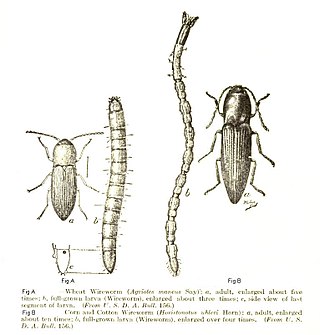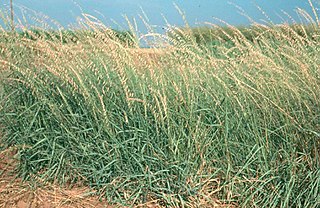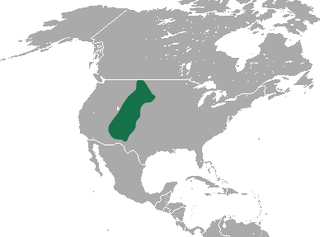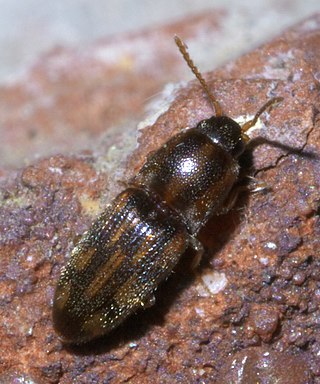
The Southwestern United States, also known as the American Southwest or simply the Southwest, is a geographic and cultural region of the United States that includes Arizona and New Mexico, along with adjacent portions of California, Colorado, Nevada, Oklahoma, Texas, and Utah. The largest cities by metropolitan area are Phoenix, Las Vegas, El Paso, Albuquerque, and Tucson. Before 1848, in the historical region of Santa Fe de Nuevo México as well as parts of Alta California and Coahuila y Tejas, settlement was almost non-existent outside of Nuevo México's Pueblos and Spanish or Mexican municipalities. Much of the area had been a part of New Spain and Mexico until the United States acquired the area through the Treaty of Guadalupe Hidalgo in 1848 and the smaller Gadsden Purchase in 1854.

Elateridae or click beetles are a family of beetles. Other names include elaters, snapping beetles, spring beetles or skipjacks. This family was defined by William Elford Leach (1790–1836) in 1815. They are a cosmopolitan beetle family characterized by the unusual click mechanism they possess. There are a few other families of Elateroidea in which a few members have the same mechanism, but most elaterid subfamilies can click. A spine on the prosternum can be snapped into a corresponding notch on the mesosternum, producing a violent "click" that can bounce the beetle into the air. Clicking is mainly used to avoid predation, although it is also useful when the beetle is on its back and needs to right itself. There are about 9300 known species worldwide, and 965 valid species in North America.

Bouteloua is a genus of plants in the grass family. Members of the genus are commonly known as grama grass.

Chinlea is an extinct genus of late Triassic Mawsoniid coelacanth fish found in and named after the Chinle Formation that crops out in the southwestern states of Arizona and New Mexico. The word “Chinle” comes from the Navajo word meaning "flowing out", referencing the location where water flows out of the Canyon de Chelly. They were also possibly found in the Dockum Group.

The dwarf shrew is a species of mammal in the family Soricidae endemic to Arizona, Colorado, Montana, Nebraska, New Mexico, South Dakota, Utah, and Wyoming in the United States. The type locality is Estes Park, Colorado, USA.

Diguetia is a genus of coneweb spiders that was first described by Eugène Simon in 1895. Members of this genus are six-eyed spiders that are either white or patterned. They are common in the southwestern United States and Mexico, and one species is found in Argentina. In the United States, species have been found in Arizona, California, Nevada, New Mexico, and Texas. These spiders build a tubular retreat at the tip of their tent-like webs. Once an insect is caught in the web, the spider bites it and injects venom to stop its prey from moving, later wrapping it in silk. Both males and females use stridulation while mating, with females also stridulating when harassed. Two species of jumping spiders feed on its eggs. There are eleven Diguetia species.

Coneweb spiders (Diguetidae) are six-eyed haplogyne spiders that live in tangled space webs, fashioning a cone-like central retreat where they hide and lay eggs. It is a small family, containing only two genera split between a range in the Southwestern United States and Mexico and a range in South America. Members of the genus Diguetia usually build their webs in shrubs or between cactus pads. They have the same eye arrangement as the venomous recluse spiders, but none are known to be harmful to humans.

Hemicalypterus is an extinct genus of prehistoric ray-finned fish that lived during the late Triassic period. It contains a single species, Hemicalypterus weiri. Fossils have been collected in the southwestern United States, including Utah and New Mexico. Hemicalypterus belonged to the family Dapediidae, and like other members of its family, it was a deep-bodied fish with a covering of thick ganoid scales. It differed from other dapediids in lacking scales on the posterior part of the body, and in possessing unusual, multicuspid teeth. These teeth were similar to those of modern-day herbivorous fish, which indicates that Hemicalypterus may have been a herbivore as well.

Geonemini is a weevil tribe in the subfamily Entiminae.

Monocrepidius is a genus of click beetles in the family Elateridae. The genus has often been cited as Conoderus, but of the two names for this genus published simultaneously in 1829, the one selected by the First Reviser under the ICZN was Monocrepidius, rendering Conoderus the junior synonym.

Limonius is a genus of click beetles in the family Elateridae. Many of the species formerly placed in this genus have been removed to other genera such as Gambrinus.

Elaterinae is a subfamily of click beetles in the family Elateridae, containing 12 tribes worldwide.

Neofidia is a genus of leaf beetles in the subfamily Eumolpinae. It is distributed in North and Central America. There are 24 species recognised in Neofidia.

Orthostethus is a genus of click beetles in the family Elateridae. There are at least two described species in Orthostethus.

Megapenthes is a genus of click beetles in the family Elateridae. There are at least 30 described species in Megapenthes.

Ampedus is a genus of click beetles in the family Elateridae. There are currently 461 recognized species of Ampedus beetles. It has a cosmopolitan distribution, but is found mostly in the Holarctic region, primarily in North America, Europe, and Asia. The oldest known fossil from this genus was found in Eocene Baltic amber, estimated to be from 38.0 to 33.9 million years ago.

Charles Frederic August Schaeffer was an American entomologist who specialized in beetles, particularly chrysomelids and weevils. He described 109 species in 91 genera and some species like Taphrocerus schaefferiNicolay & Weiss were described from his collections and named after him.
Paracardiophorus is a genus of beetles belonging to the family Elateridae.

Diplostethus opacicollis is a species of click beetle in the family Elateridae, found in the southwestern United States.

Dipropus is a genus of click beetles in the family Elateridae. There are around 150 described species in Dipropus, found in North, Central, and South America.


















